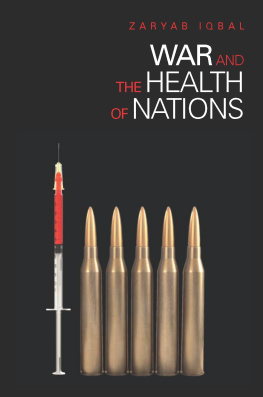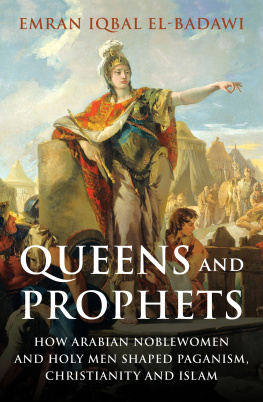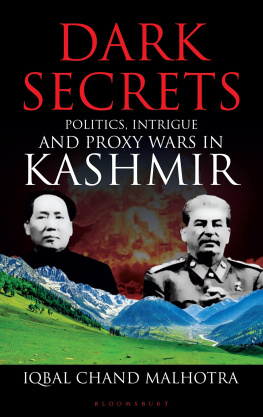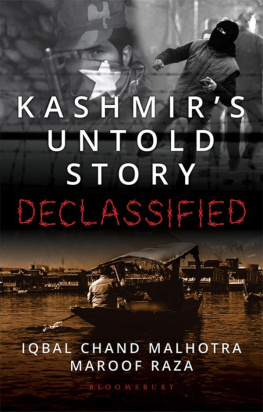War and the Health of Nations
Zaryab Iqbal
Stanford University Press
Stanford, California
2010 by the Board of Trustees of the Leland Stanford Junior University. All rights reserved. No part of this book may be reproduced or transmitted in any form or by any means, electronic or mechanical, including photocopying and recording, or in any information storage or retrieval system without the prior written permission of Stanford University Press.
Printed in the United States of America on acid-free, archival-quality paper
Library of Congress Cataloging-in-Publication Data
Iqbal, Zaryab.
War and the health of nations / Zaryab Iqbal.
p. cm.
Includes bibliographical references and index.
9780804773706
1. WarHealth aspects. 2. WarMedical aspects. 3. War and society.
4. Public health. I. Title.
RA646.I67 2010
362.1dc22 2009029235
Typeset by Westchester Book Group in 10/14 Minion
I dedicate this book to my parents
ACKNOWLEDGMENTS
THE PROCESS OF CRAFTING THIS BOOK has made me recognize the importance of professional and personal support systems in our ability to pursue scholarly work, and how much we benefit from existing academic infrastructures. Since beginning this project, I have accumulated many debts of gratitude; support from numerous individuals and institutions has been invaluable in its completion. This project began as my PhD dissertation at Emory University, where I benefited tremendously from the encouraging and inspiring scholarly environment of the Political Science Department. My adviser, David Davis, provided me with constant support throughout my graduate career and taught me to think outside the box. His encouragement was instrumental in helping me come up with a unique dissertation topic, which later morphed into this book. Dan Reiter, Suzanne Werner, and Eric Reinhardt offered valuable comments and suggestions, as well as general support and encouragement, for the improvement of the project.
I owe a great deal to the Department of Political Science and its faculty at the University of South Carolina (USC) for providing me with an excellent working environment during the early years of my career. My discussions with Harvey Starr contributed greatly to the development of this project, and I am very grateful to him for the interest that he has taken in my professional growth; I thank him for being a superb mentor, colleague, and friend. I also benefited immensely from my interactions with a number of other colleagues at USC, including Ann Bowman, Roger Coate, David Darmofal, Jill Frank, Don Puchala, Don Songer, and Neal Woods.
I am also very fortunate to be part of the collegial, supportive, and academically rigorous Department of Political Science at Pennsylvania State University. I would like to thank my colleagues at Penn State for motivating me through the final stages of this book project, particularly Donna Bahry, Frank Baumgartner, Scott Bennett, Doug Lemke, and Glenn Palmer. I want to offer special thanks to James Eisenstein for his comments on the manuscript, and I appreciate Julie Pachecos help in proofreading.
The quality of this book has been significantly enhanced by the comments and suggestions of two anonymous reviewers chosen by Stanford University Press. I also appreciate the assistance that I have received from the editorial staff of the Press, especially Stacy Wagner and Jessica Walsh.
I would like to thank my sisters and parents for their love and support over the years. Finally, I would like to acknowledge Christopher Zorn for the prodigious role he has played in the cultivation of this project, and for keeping me going through the best of times and the worst of times. At each stage of the project, I have gained from his insights and assistance. In addition to his indispensable advice on methodology, he has been a source of unwavering support and encouragement. I thank him for inspiring me as a political scientist, for challenging me to do my best, and for believing in me.
1
INTRODUCTION
SINCE THE END OF WORLD WAR II, there have been numerous interstate and intrastate conflicts resulting in millions of deaths and billions of dollars worth of destruction. Yet scholars have paid very little attention to the consequences of conflict, in particular to its social consequences. The World Health Organizations (WHO) 2002 World Report on Violence and Health revealed that 1.6 million people die each year due to violence, including collective violence such as conflicts within or between states, and a large number of the people who lose their lives due to militarized conflict are noncombatants. The 25 largest instances of conflict in the twentieth century led to the deaths of approximately 191 million people, and 60 percent of those fatalities occurred among people who were not engaged in fighting (World Health Organization 2002a). One of the most significant effects of war is the toll it takes on the health and well-being of a population beyond the immediate casualties of combat. In this book, I assess the costs of armed conflict by explaining the relationship between armed conflict and public health.
War leads to direct casualties and deaths during combat; violent conflict also results in widespread death and disability among the civilian populations that are affected either as collateral damage or as deliberate targets. For instance, Russia lost 10.1 percent of its population during World War II, Korea lost 10 percent of its population during the Korean War, and Vietnam lost 13 percent of its population during the Vietnam War (Garfield and Neugut 1997). In addition to direct deaths and injuries caused by combat among the military and civilian populations, conflict results in conditions that contribute to the spread of disease and retardation of health care systems, such as the influenza outbreak during World War I, which killed more people than combat-related deaths. The disease and disability during and after armed conflict is often accompanied by states inability to meet the public health needs of their populations if their health care infrastructure has been damaged or destroyed. Moreover, wars are associated with the creation of suboptimal health conditions that result in hazards such as famine, epidemics, weapons-induced pollution, lack of clean water, poor sanitation, and general indigence. Consequently, the population is exposed to new health threats without access to proper health care.
Studying the relationship between conflict and health is particularly important in light of the nature of conflicts in the current international system. Most of the recent and ongoing conflicts in the world are civil or intrastate wars that lead to large-scale devastation of a states infrastructure since all the fighting occurs on the territory of one state. This amplifies the conditions that deteriorate the health of societies. Civil conflict is also highly likely to result in displacement of people as refugees or internally displaced persons, exposing communities to health menaces. The crisis in Liberia effectively demonstrates the suffering civil war can inflict on a population. In June 2003, as the Liberian capital of Monrovia was engulfed in violence, the city experienced an outbreak of cholera, and within three months, 6,353 cases of cholera had been reported (World Health Organization 2003). The civil war made it impossible for either Liberian authorities or international agencies to carry out the extensive process of water chlorination that could halt further spread of the disease. Moreover, afflicted people were unable to access medical facilities due to the security situation. In September 2003, the WHO reported that only 32 percent of the Liberian population had access to clean water, no more than 30 percent of the population had access to latrines, and there had been no regular garbage collection in Monrovia since 1996. The SKD Stadium, the largest camp for internally displaced people in Monrovia, housed about 45,000 people who cook and sleep in any sheltered spot they can find, in hallways and in tiny slots under the stadium seats, with six nurses in the health center for 400 daily patients (World Health Organization 2003). After the civil war, the life expectancy in Liberia remains 41 years.









